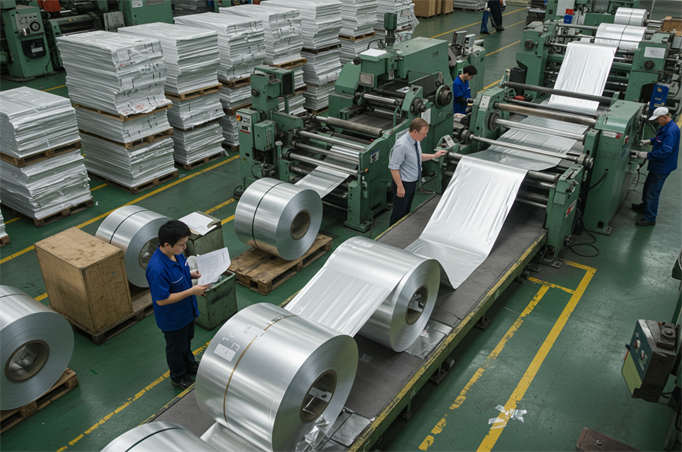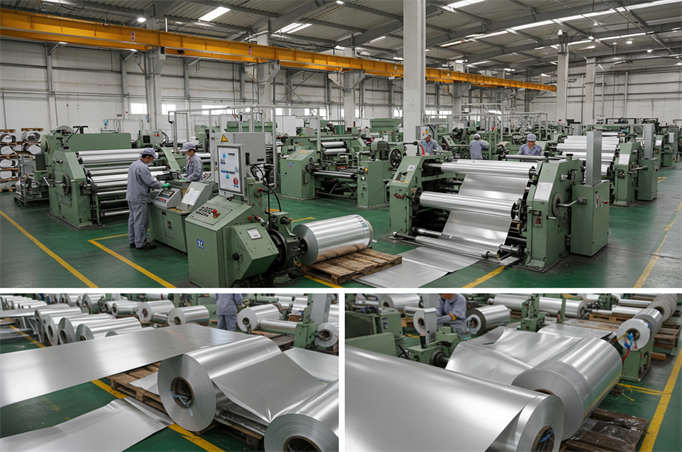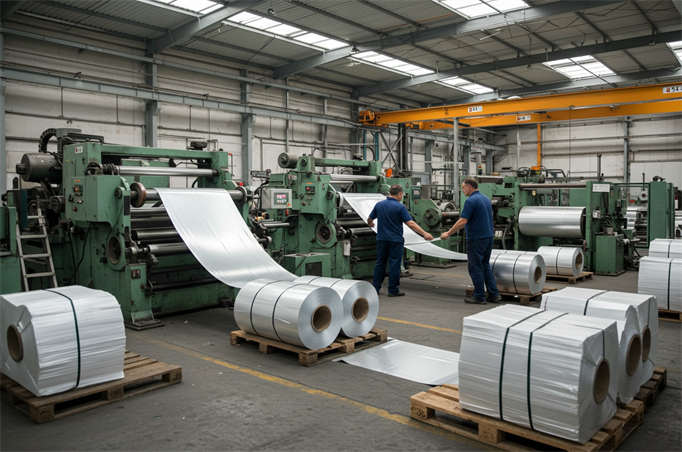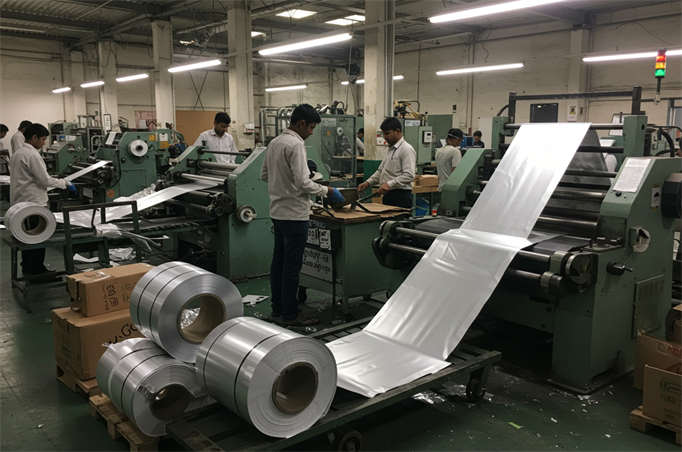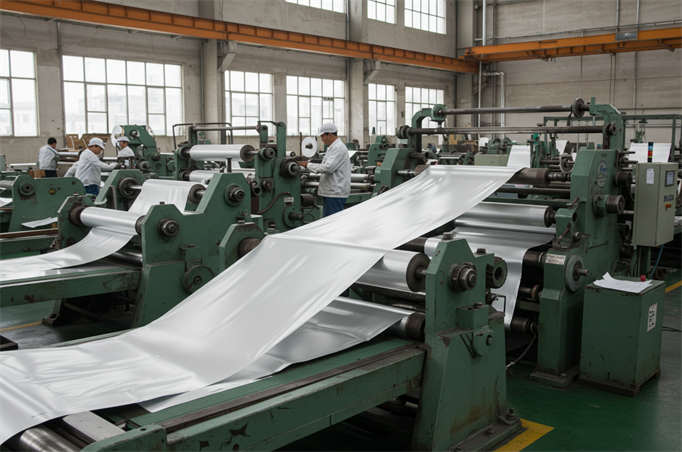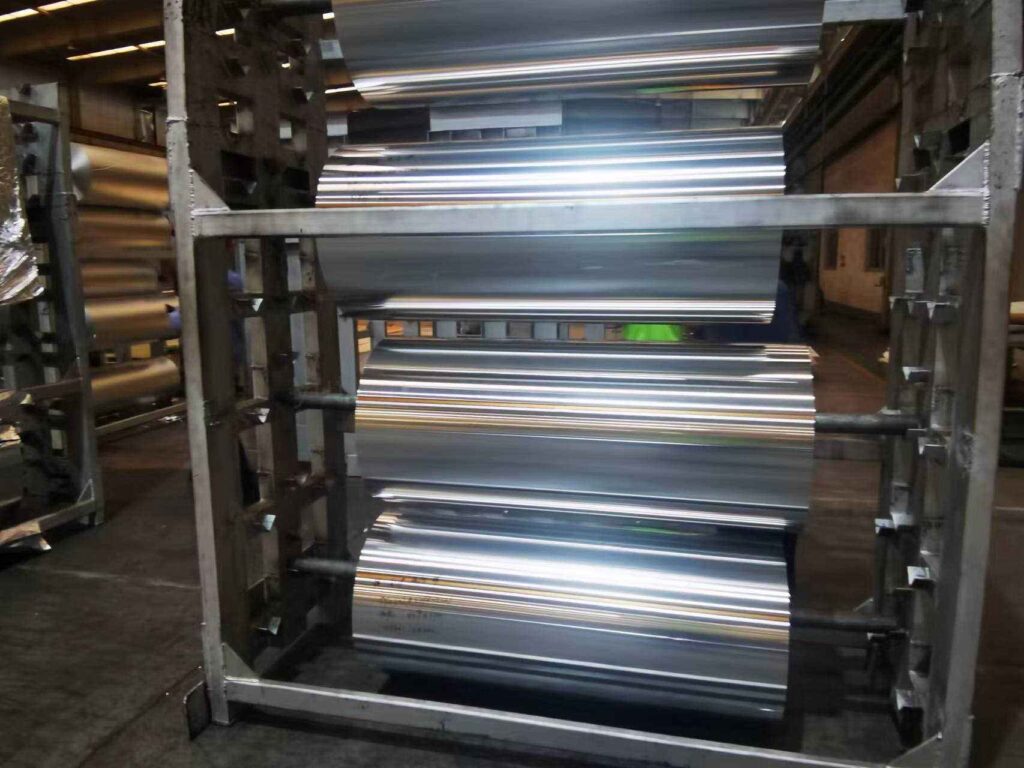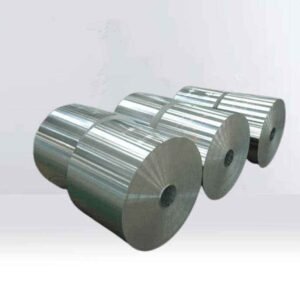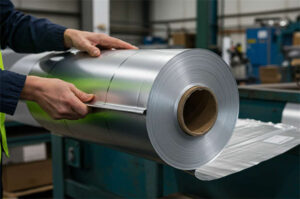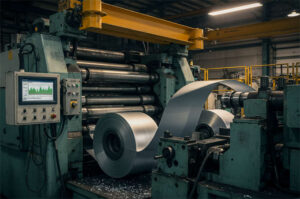Welcome to Yutwin Aluminum Foil’s blog, your trusted source for all things related to aluminum and its applications across various industries. Today, we dive deep into the fascinating world of سبائك الألومنيوم and their densities. The “density of aluminum” is a pivotal factor influencing its performance and suitability in different sectors.
Aluminum, celebrated for its lightweight yet strong properties, is widely used in aerospace, automotive, construction, packaging, and other industries. Understanding its density is crucial for engineers, architects, designers, and anyone working with aluminum materials. In this comprehensive blog post, we will explore what defines aluminum density, how it varies across different alloy series, and the multitude of factors affecting it
Our mission at Yutwin Aluminum Foil is to provide accurate, insightful, and actionable information to our audience. We aim to equip you with knowledge that empowers you to make informed decisions when selecting aluminum products. Whether you’re specifying materials for a construction project or selecting packaging solutions, understanding how aluminum density affects performance is invaluable.
Stay tuned as we explore the science behind aluminum density, its practical applications, and its significance in the real world. By the end of this post, you’ll have a deeper appreciation for this remarkable metal and its role in shaping modern industries.
At Yutwin Aluminum Foil, we often work with aluminum alloys. The density of aluminum alloys typically ranges between 2.48 and 2.93 g/cm³.
Density Examples of Different Aluminum Alloy Series
We see variations in density across different aluminum alloy series:
- 2xxx Series Aluminum Alloys: These alloys, with copper as their primary alloying element, generally have a density range of 2.7 to 2.85 g/cm³. For instance, 2024 aluminum alloy has a density of approximately 2.78 grams per cubic centimeter. These high-strength alloys are commonly used in aerospace components, such as aircraft wings and fuselage structures.
- 6xxx Series Aluminum Alloys: Magnesium and silicon are the primary alloying elements in this series, and their density typically ranges from 2.65 to 2.75 g/cm³. 6061 aluminum alloy, with a density of about 2.7 g/cm³, offers good formability and corrosion resistance. We use it extensively in construction and transportation, for example, in automotive body panels and window frames.
- 7xxx Series Aluminum Alloys: Zinc is the primary alloying element in this series, resulting in a density range of 2.7 to 2.8 g/cm³. 7075 aluminum alloy, for example, has a density of approximately 2.8 grams per cubic centimeter. Its high toughness makes it a frequent choice for aircraft structural components, such as landing gear.
Factors Affecting Aluminum Alloy Density
Several factors influence the density of aluminum alloys:
- Type and Proportion of Alloying Elements: Different elements have different densities, and the type and proportion of added elements change the overall density of the aluminum alloy. For example, magnesium has a density of approximately 1.74 g/cm³, copper هو approximately 8.96 g/cm³, and zinc هو approximately 7.14 g/cm³. When we add these elements to aluminum, the density of the aluminum alloy changes.
- Preparation Process: Processes like alloy smelting, casting, and heat treatment also influence density. During smelting, if residual gases don’t entirely escape, they can form voids within the alloy, causing the actual density to be slightly lower than the theoretical density.
How Aluminum Alloy Density Impacts Building Structures
The density of aluminum alloys, ranging from 2.65 to 2.80 grams per cubic centimeter, is approximately one-third that of steel. This characteristic significantly impacts engineering structures:
Impact on Building Structure Design
- Reduced Dead Load: The low density of aluminum alloys makes them an ideal choice for lightweight building structures. Using aluminum alloys effectively reduces the overall weight of buildings, which is especially important for long-span structures, high-rise buildings, and constructions in earthquake-prone areas. Reducing dead load not only lowers the requirements for bearing capacity but also improves structural stability and safety.
- Increased Structural Efficiency: Aluminum alloys offer high strength and a high strength-to-weight ratio. They allow for smaller cross-sections and high load-bearing capacity, increasing structural efficiency. هذا enables designers to reduce component sizes while ensuring structural safety, optimizing structural layout, and saving material consumption.
Impact on Construction
- Easier Transportation and Installation: Because aluminum alloys are lightweight, transportation and installation processes are more convenient. هذا reduces transportation costs and construction difficulty, accelerating construction progress. Additionally, we typically prefabricate aluminum alloy structural components, such as profiles and connection plates, in factories using CNC machining, ensuring high production accuracy. هذا enables fully prefabricated assembly, further reducing construction periods.
- Reduced On-Site Processing: Aluminum alloy structures feature a high degree of prefabrication. Compared to steel, wood, or concrete structures, we need very little additional on-site processing. هذا not only boosts construction efficiency but also reduces potential errors and quality risks associated with on-site fabrication.
Impact on Building Performance
- Better Durability: Aluminum alloys offer higher corrosion resistance, allowing for long-term use in humid or corrosive environments. هذا reduces maintenance and replacement frequency. هذا is a clear advantage in coastal cities, industrial areas, and harsh environments, such as those found in swimming pools, greenhouse exhibition halls, and petrochemical industries.
- Excellent Thermal Conductivity: Aluminum alloys have excellent thermal conductivity, making them suitable for building heat dissipation systems and improving energy efficiency. For example, using aluminum alloys in building equipment or structural components that require efficient heat dissipation can reduce energy consumption.
Impact on Building Aesthetics and Sustainability
- Unique Metallic Texture: Aluminum alloys possess a unique metallic texture and luster. Their surface requires no special treatment for decorative effects, achieving the goal of “structure as decoration” and providing enhanced aesthetic choices for architectural design.
- Lower Life Cycle Costs: إن مقاومة التآكل and recyclability of aluminum alloys result in lower maintenance costs and a reduced environmental impact. Their high recyclability aligns with the trend of green building development, contributing to the sustainable development of structures.
Factors Related to Aluminum Alloy Density
The density of aluminum alloys primarily depends on these conditions:
Type and Composition of Alloying Elements
- Adding High-Density Elements: Incorporating high-density elements like copper, zinc, or nickel into aluminum increases the density of the aluminum alloy. For instance, 2xxx series aluminum alloys, which include copper, and 7xxx series aluminum alloys, which include zinc, gradually exhibit higher densities than pure aluminum. As an example, 2024 aluminum alloy (with Cu 3.8-4.9%, Mg 0.8-1.2%, Mn 0.3-0.9%, Si up to 0.6%, and Zn up to 0.6%) has a density of approximately 2.78 g/cm³.
- Adding Low-Density Elements: Adding low-density elements, such as magnesium or silicon, reduces the density of the aluminum alloy. For example, 6xxx aluminum alloys, which incorporate magnesium and silicon, have a density lower than pure aluminum. Our 6061 aluminum alloy (with Mg 0.8-1.2% and Si 0.4-0.8%) has a density of around 2.7 g/cm³.
Microstructure of the Alloy
- Grain Size and Distribution: A fine and uniform grain distribution enables the alloy to approach its theoretical density more closely. If grains are coarse or unevenly distributed, they can easily form pores or defects, resulting in an actual density that is lower than the theoretical value.
- Phase Composition and Structure: The different phases within the alloy exhibit varying densities. The number, size, shape, and distribution of second-phase particles affect the overall density of the alloy. For example, in 7075 aluminum alloy, second phases, such as the η phase (CuAl₂), have a different density than the matrix, which influences the overall alloy density.
- Porosity and Defects: Pores, shrinkage, and other issues arising during casting can create internal voids in the alloy, reducing its actual density. Voids and inclusions during processing can also affect density.
Preparation Process
- Smelting Process: The smelting temperature, duration, and stirring parameters influence the solubility and uniformity of alloy components. Prolonged high-temperature smelting can cause element burnout, changing the alloy composition and density. Thorough stirring ensures uniform element distribution, improving alloy density and bringing it closer to the theoretical value.
- Casting Process: Casting methods (such as sand casting, permanent mold casting, and die casting) affect the alloy’s solidification rate and shrinkage level. Die casting can solidify the alloy under high pressure, reducing pores and looseness and increasing density.
- Forming Process: Hot working (such as forging, cold rolling, extrusion, etc.) affects density by adjusting the alloy’s microstructure and promoting densification. Cold working introduces work hardening and residual stress, which can create micro-cracks that reduce material density.
Environmental Factors
- Temperature: As the temperature increases, aluminum alloys thermally expand, rising in volume while the mass remains constant, thus decreasing their density. Different aluminum alloys have different coefficients of thermal expansion and density changes with temperature.
- Pressure: Under extremely high pressure, the internal molecular spacing of aluminum alloys decreases, resulting in a contraction of the volume, which can potentially lead to a slight increase in density. However, within the typical range of architectural applications, pressure has a negligible effect on the density of aluminum alloys.
- Corrosion and Oxidation: Long-term use of aluminum alloys in corrosive environments can lead to reactions, forming an oxide layer or corrosion products on the surface. The density of the oxide layer differs from that of the base material, which may result in a slight change in overall density. For instance, after anodizing the surface of an aluminum alloy, the density changes slightly due to the coverage of the oxide film.
How Does Aluminum Alloy Density Change with Temperature?
إن density of aluminum alloys changes with temperature. Here’s a look at the trend and underlying reasons:
Trend Analysis
- Linear Thermal Expansion Coefficient: Aluminum alloys have a linear thermal expansion coefficient of approximately 22.3 × 10⁻⁶/°C. Generally, as temperature increases, aluminum alloy materials expand, their volume increases, and their mass remains constant. According to the density formula, ρ = m/V, their density decreases. Conversely, when temperature decreases, aluminum alloy materials contract, their volume decreases, and their density increases.
- Density-Temperature Coefficient of Different Aluminum Alloy Grades: Because of variations in composition and microstructure, the density change with temperature differs for various grades of aluminum alloy. For example, for 2219 aluminum alloy, the relationship between density and temperature is ρ(t) = ρ(68°F)[1 – 3αₐᵥ(t – 68°F)], where ρ(68°F) = 0.102 lb/cu in and αₐᵥ is the average coefficient of thermal expansion.
Here is the density reference chart for common aluminum alloys
| Alloy Series | Alloy Grade | Density (g/cm³) |
|---|---|---|
| 1xxx | 1A99 | 2.705 |
| 1xxx | 1070A | 2.705 |
| 1xxx | 1060 | 2.705 |
| 1xxx | 1050, 1050A | 2.705 |
| 1xxx | 1035 | 2.705 |
| 1xxx | 1145 | 2.700 |
| 1xxx | 1100 | 2.710 |
| 1xxx | 1200 | 2.700 |
| 1xxx | 1235 | 2.705 |
| 2xxx | 2011 | 2.760 |
| 2xxx | 2014A | 2.780 |
| 2xxx | 2017A | 2.760 |
| 2xxx | 2018A | 2.780 |
| 2xxx | 2024 | 2.780 |
| 3xxx | 3003 | 2.730 |
| 3xxx | 3A21 | 2.730 |
| 5xxx | 5A02 | 2.660 |
| 5xxx | 5052 | 2.680 |
| 5xxx | 5056 | 2.640 |
| 5xxx | 5083 | 2.660 |
| 5xxx | 5086 | 2.660 |
| 6xxx | 6026 | 2.710 |
| 6xxx | 6061 | 2.710 |
| 6xxx | 6063 | 2.710 |
| 6xxx | 6082 | 2.710 |
| 7xxx | 7010 | 2.830 |
| 7xxx | 7050 | 2.810 |
| 7xxx | 7075 | 2.810 |
| 8xxx | 8A06 | 2.710 |
| 8xxx | 8011 | 2.710 |
| LF Series | LF3 | 2.670 |
| LF Series | LF5 | 2.650 |
| LF Series | LF6 | 2.640 |
| LF Series | LF10 | 2.650 |
| LF Series | LF11 | 2.650 |
| LF Series | LF12 | 2.630 |
| LY Series | LY1 | 2.760 |
| LY Series | LY2 | 2.750 |
| LY Series | LY6 | 2.760 |
| LY Series | LY7 | 2.760 |
| LY Series | LY8 | 2.800 |
| LY Series | LY9 | 2.800 |
| LY Series | LY10 | 2.800 |
| LY Series | LY11 | 2.800 |
| LY Series | LY12 | 2.780 |
| LY Series | LY16 | 2.840 |
| LY Series | LY17 | 2.840 |
| LD Series | LD2 | 2.700 |
| LD Series | LD5 | 2.750 |
| LD Series | LD6 | 2.750 |
| LD Series | LD7 | 2.800 |
| LD Series | LD8 | 2.770 |
| LD Series | LD10 | 2.800 |
| LC Series | LC3 Ultra-hard Aluminum Alloy | 2.850 |
| LC Series | LC4 Ultra-hard Aluminum Alloy | 2.850 |
| LC Series | LC6 Ultra-hard Aluminum Alloy | 2.890 |
| LC Series | LC9 Ultra-hard Aluminum Alloy | 2.850 |
| ZL Series | ZL101 | 2.660 |
| ZL Series | ZL102 | 2.650 |
| ZL Series | ZL103 | 2.700 |
| ZL Series | ZL104 | 2.650 |
| ZL Series | ZL105 | 2.680 |
| ZL Series | ZL201 | 2.780 |
| ZL Series | ZL203 | 2.800 |
| ZL Series | ZL301 | 2.550 |
| ZL Series | ZL401 | 2.950 |
Underlying Reasons
- Microstructural Changes: As the temperature increases, the movement of atoms and crystals within the aluminum alloy intensifies, causing the spacing between crystals to expand, resulting in an overall volume expansion of the material و a decrease in density. At the same time, increasing temperature affects the shape, distribution, and quantity of second-phase particles in the alloy, which in turn influences the alloy’s density.
- Different Thermal Expansion Coefficients: Various aluminum alloys exhibit distinct thermal expansion coefficients, primarily due to variations in the type and composition of alloying elements. For example, in high-silicon aluminum alloys, when the extrusion temperature is low, we observe tiny, dispersed silicon particles within the alpha-phase aluminum matrix. These particles inhibit the expansion of the matrix, resulting in a higher number of residual pores. These pores do not expand when heated and can act as zero-stiffness third phases, reducing the material’s thermal expansion coefficient and resulting in relatively small density changes. As the extrusion temperature increases, the amount of silicon in the supersaturated alpha-phase gradually decreases, the constraining effect of the silicon phase diminishes, the expansion coefficient increases, and the density decrease becomes relatively more significant.
In summary, the density of aluminum alloys decreases as temperature increases and increases as temperature decreases. The fundamental reasons are that temperature changes cause the aluminum alloy material to expand or contract in volume, and they also affect the internal microstructure and thermal expansion coefficient.
The Density of Aluminum Foil
| Type of Aluminum Foil | Density (g/cm³) |
|---|---|
| Industrial Pure Aluminum Foil | 2.70 |
| LF1 Aluminum Alloy Foil | 2.73 |
| 5A02 (LF2) Aluminum Alloy Foil | 2.67 |
| 2A12 (LY12) Aluminum Alloy Foil | 2.79 |
| 2A13 (LY13) Aluminum Alloy Foil | 2.80 |
Aluminum foil, made from metallic aluminum or aluminum alloys through a rolling process, has a density close to that of pure aluminum, generally around 2.7 g/cm³. هذا is because, even though we add some alloying elements during aluminum foil production, the main component remains aluminum, resulting in a density similar to pure aluminum. The density of different brands of aluminum foil may vary slightly due to the type and composition of alloying elements. For example, LF1 aluminum alloy foil has a density of 2.73 g/cm³, 5A02(LF2) aluminum alloy foil has a density of 2.67 g/cm³, 2A12(LY12) aluminum alloy foil has a density of 2.79 g/cm³, and 2A13(LY13) aluminum alloy foil has a density of 2.80 g/cm³.
Thank you for joining us on this journey through the intricate topic of aluminum density. At رقائق الألومنيوم يوتوين, we are committed to being your go-to resource for everything aluminum. From this detailed exploration of the “density of aluminum,” it’s clear that understanding this fundamental property is key to unlocking the full potential of aluminum in countless applications.
We hope this blog post has equipped you with valuable insights and practical knowledge. Whether you’re an industry professional seeking technical details or a curious reader interested in material science, we’re glad to have shared our expertise with you. Remember, the right aluminum product, matched to its intended use through careful consideration of density and other properties, can significantly enhance efficiency, durability, and sustainability in your projects.
For more in-depth information, customized solutions, or to discuss your specific aluminum needs, we invite you to visit our website or contact our dedicated team. Your success in utilizing aluminum effectively is our priority, and we’re here to support you every step of the way. Don’t hesitate to reach out – your next innovative project might start with a conversation about aluminum density!
Do you have more questions about the density of aluminum or its applications in specific products? We’re here to help!

